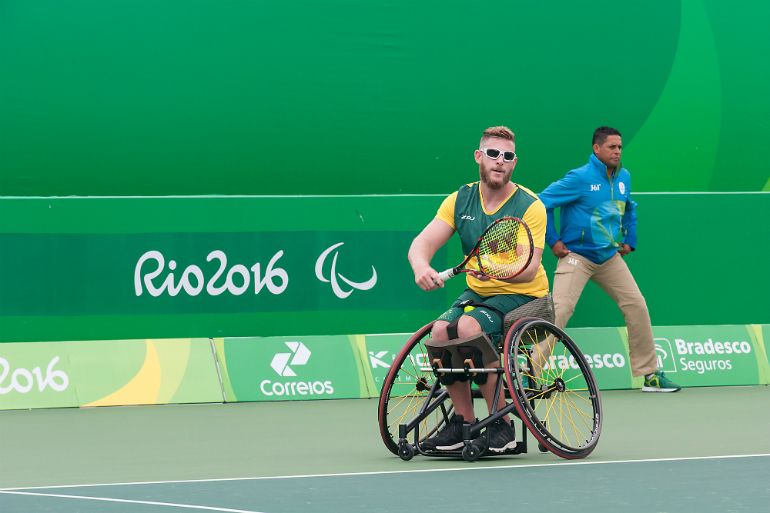Share:
Take it offline!
This Education in Motion resource is also available as a printable PDF.
Download PDF
Tennis is a beloved sport in Australia, both as a hobby and on the professional circuit. Our prestigious national competitions, such as the Australian Open, draw crowds of avid tennis enthusiasts and casual fans alike to celebrate the successes of the Australian sporting community.
As with many sports, tennis has been adapted to include athletes with disabilities on a local, national, and worldwide scale. According to Tennis Australia, athletes are allowed two bounces of the ball, but otherwise, the game remains much the same as its non-adapted counterpart. The vast majority of our national tennis competitions now include adapted categories, but there is also an entire wheelchair tennis circuit of its own in Australia.
Despite what the title of the sport may suggest, athletes do not necessarily need to use a wheelchair in order to play. To be eligible for competition, Disability Sports Australia says that an athlete must have a substantial loss of function in one or both lower extremities caused by medically diagnosed and permanent mobility-related physical disability.
Competition Classifications
Wheelchair tennis athletes are assigned a classification according to their functional ability, and are categorized into either the open or quad divisions.
The open division is for players with a permanent, substantial or total loss of function in one or both legs, and the quad division is for players with substantial loss of movement in one of both legs and one or both arms. In the quad division, athletes can often be quadriplegic and so the use of an electric wheelchair may be implemented during game play.
A player’s division is determined by a panel of approved classifiers, who observe the athlete during practice, warm up, and play in order to reach a decision.
A Brief History of Wheelchair Tennis
Wheelchair tennis heralds a rich and successful history from its humble inception in 1976. The International Tennis Federation highlights the peaks and lows of the sport over the past 40 years in its piece on the history of wheelchair tennis.
1976: At just 18 years old, athlete Brad Parks suffers an injury while skiing which leaves him paraplegic. During his rehabilitation sessions, he discusses the possibilities of accessible sport with Jeff Minnenbraker, and the idea of wheelchair tennis is born.
1977: Brad and Jeff begin to promote the sport in the US, and establish regulations for the game. In May 1977, the LA City Parks and Recreation Department hosts the first wheelchair tennis tournament, which attracts 20 players.
1980: The National Foundation of Wheelchair Tennis is formed. 10 tournaments are organised across the US, including the US Open Wheelchair Tennis Championships. This event attracts over 70 players, showing substantial growth from the first match in 1977.

Team Sunrise ambassador Ben Weekes uses a RGK GrandSlam when training or competing
1989: In Sydney, Australia, Graeme Watts organises the first Australian wheelchair tennis program after receiving guidance from Brad Parks and Jim Worth.
1992: Wheelchair tennis becomes recognised as a full medal sport at the Paralympics.
2000: In order to bring the sport up to standard with non-adapted tennis, an anti-doping program is developed and introduced.
2002: The Australian Open becomes the first non-adapted Grand Slam event to feature wheelchair tennis.
2005: The first ever Wimbledon wheelchair tennis tournament is staged.
2012: Eton Manor, a brand new tennis center at the Olympic Park, plays host to the wheelchair tennis events of the London 2012 Paralympic Games. The Games go down as the most successful in Paralympic history.
2016: Athletes and fans across the world celebrate the 40th anniversary of wheelchair tennis.
Wheelchair Tennis Tournaments in Australia
Tennis Australia maintains a yearly calendar of adapted tennis tournaments across the country, from the Sydney International Wheelchair open in January to the Australian National Tennis Wheelchair Championships at the end of the season in November.
Of particular note are the Australian Open wheelchair tennis matches from January 24-27, 2018, and the upcoming Invictus Games tournaments held in Sydney from October 22-23, 2018.
The Invictus Games is an international event highlighting multiple adaptive sports. The Games were founded by His Royal Highness Prince Harry in 2014, and are geared towards the competitive sporting endeavours of wounded, injured, and sick defense personnel and veterans.
The Tennis Wheelchair
As in most of the adapted sports, the tennis wheelchair needs to have specific features to enable the game performance.
The Quickie Match Point is fitted with a patented system that allows for center-of-mass adjustment, attending to certain requirements, like adjustments in the center of gravity or the seat angle of each player. You will also be able to choose two camber posibilities (16 and 20º), providing great stability and easiness to turn.
On the other hand, the Quickie Match Point TI is equipped with a titanium frame structure, offering considerable weight cuts and making it perfect for the most demanding athletes.
Within our RGK sport wheelchairs range, there's also a tennis choice. RGK Grand Slam is ideal for competitive wheelchair tennis. It is fitted with an anti tip system and adjustable knee supports.
Have you already made your choice?